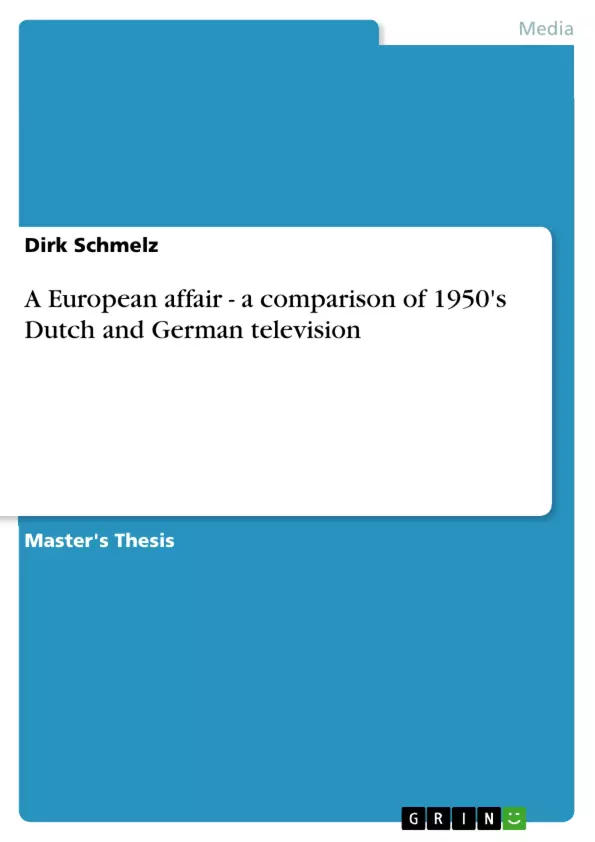Die in englisch verfasste Arbeit gibt einen Überblick über die Anfänge des Fernsehens in den 50er Jahren in den Niederlanden und in Deutschland und zieht anhand von demographischen, politischen, gesellschaftlichen, soziologischen und technischen Aspekten einen Vergleich, um die Frage zu beantworten, was die frühe Entwicklung des Fernsehens maßgeblich bestimmt hat. Zusätzlich sind viele zeitgenössische einmalige Quellen enthalten.
Inhaltsverzeichnis (Table of Contents)
- Introduction
- Approach
- A description of the audience in the 1950's
- Description of the mass medium
- A short prehistory of television in Germany and the Netherlands
- The same idea at different locations
- The development of the electric apparatus
- First public demonstrations in Germany
- The emergence of German television
- Programming until 1945 in Germany
- No distribution of television
- Television test in the Netherlands
- Conclusions
- The 1950's in the Netherlands
- The post-war period in the Netherlands
- The pillarisation
- Introducing television to an audience
- The test program of Philips in Eindhoven
- Missing concepts for a new medium
- The NTS - a Dutch democratic principle
- Conclusion to Introducing television to an audience
- The medium as a social institution
- Television among other Luxus
- Cinema and radio as rivals
- The political perspective
- The commercial perspective
- Conclusion to the medium as a social institution
- Looking for the audience
- The ideal of a future audience
- The media audience in the 1950's
- Programming in the 1950's
- The people in front of the camera
- Television critics
- Reactions of the audience
- Research on the audience
- Conclusions to looking for the audience
- Conclusion
- West German television in the 1950's
- The post-war period in Germany
- Federalism
- Introducing television to an audience
- The test program of the NWDR in Hamburg
- Missing concepts for a new medium
- ARD
- Conclusions to Introducing television to an audience
- The medium as a social institution
- Television among other luxuries
- Other media as rivals
- The political perspective
- The commercial perspective
- Conclusion to the medium as a social institution
- Looking for the audience
- The ideal of a future audience
- The media audience in the 1950's
- Programming in the 1950's
- The people in front of the camera
- Television critics
- Reactions of the audience
- Research on the audience
- Conclusions to looking for the audience
- Conclusion
- Comparison
Zielsetzung und Themenschwerpunkte (Objectives and Key Themes)
This research examines the emergence of television in West Germany and the Netherlands during the 1950s, comparing their development and impact on society. It aims to understand how this new medium was introduced to audiences, its place in the social landscape, and the influence it exerted on both nations.
- The introduction of television to audiences in post-war Germany and the Netherlands
- The role of television as a social institution in both countries
- The development of television programming in the 1950s
- The impact of television on audience behavior and perceptions
- A comparative analysis of television development in Germany and the Netherlands
Zusammenfassung der Kapitel (Chapter Summaries)
The introductory chapter establishes the importance of studying television as a mass medium, emphasizing the need to understand its impact on audiences. It also introduces the specific approach and scope of this research, focusing on the 1950s and the comparative analysis of German and Dutch television.
The second chapter delves into the prehistory of television in both countries, exploring the early development of the technology and its first public demonstrations. This section highlights the common origins and subsequent diverging paths of television development in Germany and the Netherlands.
Chapter three focuses on the Netherlands in the 1950s, examining the post-war social context, the process of introducing television to the Dutch audience, and the medium's evolving role as a social institution. It further analyzes the emergence of a distinct television audience, its preferences, and the development of programming in the Netherlands.
Chapter four explores the development of West German television during the 1950s, mirroring the structure of chapter three. It examines the post-war environment, the introduction of television, its social implications, and the evolution of programming and audience reception in West Germany. This chapter sets the stage for the comparative analysis in later sections.
Schlüsselwörter (Keywords)
The primary keywords for this research are: television, 1950s, West Germany, Netherlands, social institution, audience, programming, comparative analysis, post-war period, media development, cultural influence, mass media, and technology.
- Quote paper
- International Master of Arts Dirk Schmelz (Author), 1995, A European affair - a comparison of 1950's Dutch and German television, Munich, GRIN Verlag, https://www.grin.com/document/13767



